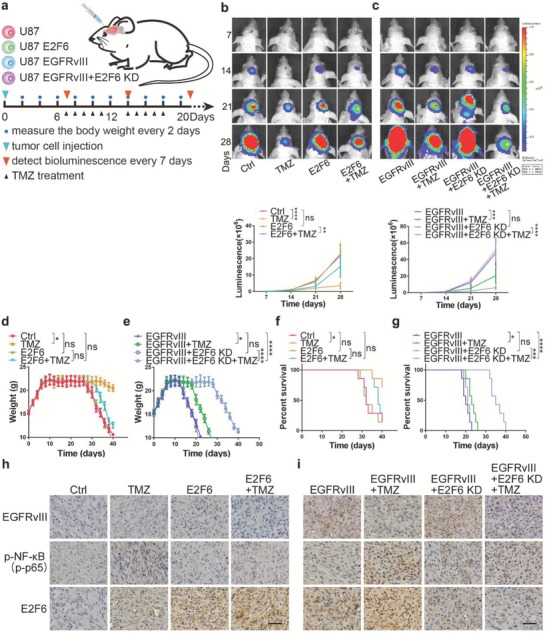Figure 6.

E2F6 is a causal factor of TMZ resistance in vivo. a) Schematic illustration of the evaluation of E2F6 as a causal factor in TMZ resistance in vivo. Mice were intracranially injected with U87, U87/E2F6, U87/EGFRvIII, or U87/EGFRvIII/E2F6 KD cells and subsequently treated by intraperitoneal injection of TMZ (5 mg kg−1 d−1) or DMSO for 2 weeks (5 days on and 2 days off) after being randomly divided into four groups (seven mice per group). Tumor growth was monitored by bioluminescence. b,c) Representative pseudocolor bioluminescence images from each group with indicated treatment underneath the images. Quantitative analysis of the photon flux is below. P value was calculated on day 28. (mean ± SD, n = 7, **P < 0.01, ***P < 0.001, ****P < 0.0001). d) The body weights of GBM‐bearing mice, which were established by intracranial injection of U87 and U87/E2F6 cells, and e) U87/EGFRvIII and U87/EGFRvIII/E2F6KD cells, after treatment with TMZ or vehicle control (*P < 0.05, ***P < 0.001, ****P < 0.0001, ns: not significant). f) Kaplan–Meier curve showed the overall survival time of GBM‐bearing mice, which were established by intracranial injection of U87 and U87/E2F6 cells, and g) U87/EGFRvIII and U87/EGFRvIII/E2F6KD cells, after treatment with TMZ or vehicle control (*P < 0.05, ***P < 0.001, ****P < 0.0001, ns: not significant). h) Representative immunostaining images of EGFRvIII, p‐NF‐κB, and E2F6 in the GBM xenografts, which were derived from U87 and U87/E2F6 cells, and i) U87/EGFRvIII and U87/EGFRvIII/E2F6KD cells, after treatment with TMZ or vehicle control. Scale bar: 50 µm.
